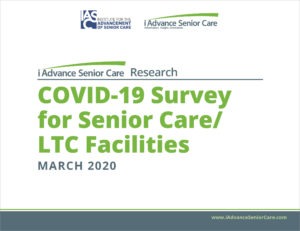Personal resident alarms: More protection or more risk?
Not all alarms are equally important. Critical alarms, such as those on ventilators and smoke detectors are essential. Likewise, alarms on intravenous pumps and exit doors are often necessary. But, what about bed and chair alarms, also known as “personal alarms”?
Prior to the Omnibus Budget Reconciliation Act of 1987 (OBRA ’87), the use of physical and chemical restraints in long-term care facilities was widespread. Following OBRA ’87’s focus on quality of care and enhanced enforcement actions, the use of restraints diminished while the use of bed and chair alarms grew exponentially. The primary purpose of bed and chair alarms is to alert staff to a potential fall when a resident attempts to get out of bed or up from a chair. Bed and chair alarms are typically pressure sensitive devices placed in beds, chair pads and wheelchair seats that respond to changes in pressure with a warning signal. Other alarms are wearable or can be attached to a resident’s clothing, programmed to activate when the person attempts to move a certain way or beyond a certain distance.
However, the widespread use of personal alarms may not be justified, and, in some cases, may be more of a liability burden than a resident benefit. Surveyors frequently ask whether alarms are used and incorporated into the care plans of residents who either fell or are at risk for falls. There is no shortage of cases where the failure of an alarm to function properly resulted in a deficiency and a civil money penalty (CMP) imposed by the Centers for Medicare and Medicaid Services (CMS). In the 2008 case JFK Hartwyck at Oak Tree v. CMS, Administrative Law Judges held that “alarms that were not working properly would not have constituted adequate assistance devices as required.” More pointedly, said judges in the 2005 case Birmingham Nursing & Rehabilitation Center—East v. CMS: “Once [the facility] opted to utilize an alarm to protect the resident, it assumed the responsibility of making sure that the alarm worked properly.” Apart from concerns about survey deficiencies, facilities need to examine if alarms are more of a problem than a solution.
Approximately 1,800 nursing home residents die each year as a result of falls, according to Falls in Nursing Homes, published by the Centers for Disease Control and Prevention (CDC). The CDC notes that the “typical nursing home” with 100 beds reports between 100 and 200 falls each year, and of those falls, 10–20 percent are associated with serious injuries.
Research published in the Journal of Nursing Care Quality suggests that little evidence exists to demonstrate that alarms prevent falls. On the contrary, evidence is growing that personal alarms create confusion, anxiety and adversely affect the quality of life of residents. Worse, alarms can be counterproductive by fostering a false sense of security for staff and creating a reactive rather than proactive paradigm.
“While alarms seem like a possible intervention to reduce the incidence of falls, they have not been effective in most cases. They have, in fact, actually contributed to unsafe environments and resulting incidents,” says Beryl Goldman, PhD, RN, NHA, director of Kendal Outreach and the outreach leader for the Food and Drug Administration’s Hospital Bed Safety Workgroup. “Staff often depend on the sound of the alarm to notify them that a person is getting out of a bed or chair but, by the time they get to the resident, the person has already gotten up and landed on the floor,” Goldman notes. “Alarms often exacerbate situations, scaring a resident into moving even faster and then falling.”
ALARM ELIMINATION PROGRAMS
In order to eliminate bed and chair alarms, facilities must have effective fall risk and prevention programs. A fall risk assessment begins at admission and includes a history of falls as well as risks related to medications, functional limitations, gait and balance abnormalities, mental status, orthostatic hypotension, underlying pathology, neurological conditions and environmental factors. The nature, frequency and causes of falls should be examined and documented as well as potential post-fall complications.
Any program aimed at eliminating bed and chair alarms must be thoroughly developed with input by clinicians from the medical director to certified nurse aides. A multidisciplinary approach is essential. Experts in the area of falls suggest a two-tiered approach, explains Laurence Rubenstein, MD, MPH, professor and chairman in the Donald W. Reynolds Department of Geriatric Medicine, University of Oklahoma College of Medicine. “Every nursing home needs a standardized fall prevention program with environmental safety adaptations as well as a systematic approach to assessing risk factors in individual residents,” Rubenstein says. “The benefits of bed alarms have not been proved.”
However, the benefits of eliminating alarms may be compelling. A Massachusetts facility was able to systematically eliminate resident alarms while experiencing a 32 percent reduction in its quarterly average for falls, according to data from the Massachusetts Quality Improvement Organization (QIO). In Connecticut, “nursing homes that have become alarm-free have reported a reduction in both falls and falls with injuries,” says Ann Spenard, vice-president of operations at Qualidigm, which has been the Connecticut Medicare QIO for thirty years.
Sue Ann Guildermann, director of education at Empira, Eden Prairie, Minn., has been helping facilities to become alarm-free. She oversaw a project at 16 facilities that eliminated their alarms within a three-month period and says the facilities experienced a reduction in falls. Guildermann stresses the importance of performing a root-cause analysis to determine what factors contributed to a fall. The root cause of a fall is not because a resident moved, she says; “the root cause is that the resident has a need, a need that set the alarm off.” She suggests that caregivers ask, “What was the resident’s need [and] what was the resident doing just prior to the alarm going off?”
The American Medical Directors Association (AMDA)—The Society for Post-Acute and Long-Term Care Medicine offers a Falls and Fall Risk Clinical Practice Guideline (CPG). Barbara Resnick, PhD, CRNP, FAAN, professor at the University of Maryland School of Nursing, has conducted several studies utilizing that CPG, which she co-authored. Her results showed that falls decreased significantly and consistently following the implementation of the guidelines.
Based on her research, Resnick stresses the importance of exercise and maximizing residents’ physical and mental conditions in order to help prevent falls and says she “strongly support[s] a move towards eliminating bed and chair alarms in the long-term care setting.”
PROBLEMS ASSOCIATED WITH BED AND CHAIR ALARMS
Personal alarms can create a host of unwanted complications, because they:
- Can create a false sense of security
- Can promote a reactive rather than proactive approach to falls
- May be inactivated by residents
- May fail through weak batteries or mechanical damage
- Can make an environment seem institutional instead of home-like
- Can create fear, confusion or agitation, especially in residents with dementia
- May reduce activities of daily living and functional status of residents
- May interfere with resident dignity
- May interfere with sleep, which contributes to agitation and decreased balance
- “Alarm fatigue” leads to staff desensitization and caregiver frustration
- May increase survey deficiencies related to alarms
- May actually lead to increase in falls and serious injuries
It is imperative not only to determine the obvious cause but to perform a root-cause analysis for falls. For example, if a resident fell while attempting to walk to the bathroom at night, look beyond the fall itself. Determine if diuretics, increased fluid intake prior to sleeping or a urinary tract infection played a role. Consider whether lighting levels or clutter on the floor may have contributed, or whether gripper slippers or a walker should have been used.
Not all falls are avoidable and some residents will continue to fall—with or without bed and chair alarms and in spite of a facility’s best efforts. For those residents, an anticipatory approach is recommended. Interventions such as keeping the bed in the lowest position, placing mats on the floor adjacent to the bed and providing hip protectors may reduce injuries.
Preventing falls in the long-term care setting requires a substantial and sustained interdisciplinary team effort. Towards that goal, the time has come to rethink the appropriateness of bed and chair alarms and to utilize more effective, evidence-based methods of reducing falls and fall-related injuries while enhancing resident dignity and quality of life.

Alan C. Horowitz, Esq., is a partner at Arnall Golden Gregory LLP, where he focuses his legal practice on regulatory compliance for skilled nursing homes, hospices and home health agencies and manages cases where the Centers for Medicare and Medicaid Services (CMS) has imposed an enforcement action. He is a former assistant regional counsel Office of the General Counsel, U.S. Department of Health and Human Services. As counsel to CMS, he was involved with hundreds of enforcement actions and successfully handled appeals before administrative law judges, the HHS Departmental Appeal Board and in federal court. He also has clinical healthcare experience as a registered respiratory therapist and registered nurse. He can be reached at alan.horowitz@agg.com.
Related Articles
Topics: Alan C. Horowitz , Executive Leadership , Risk Management , Wearables










